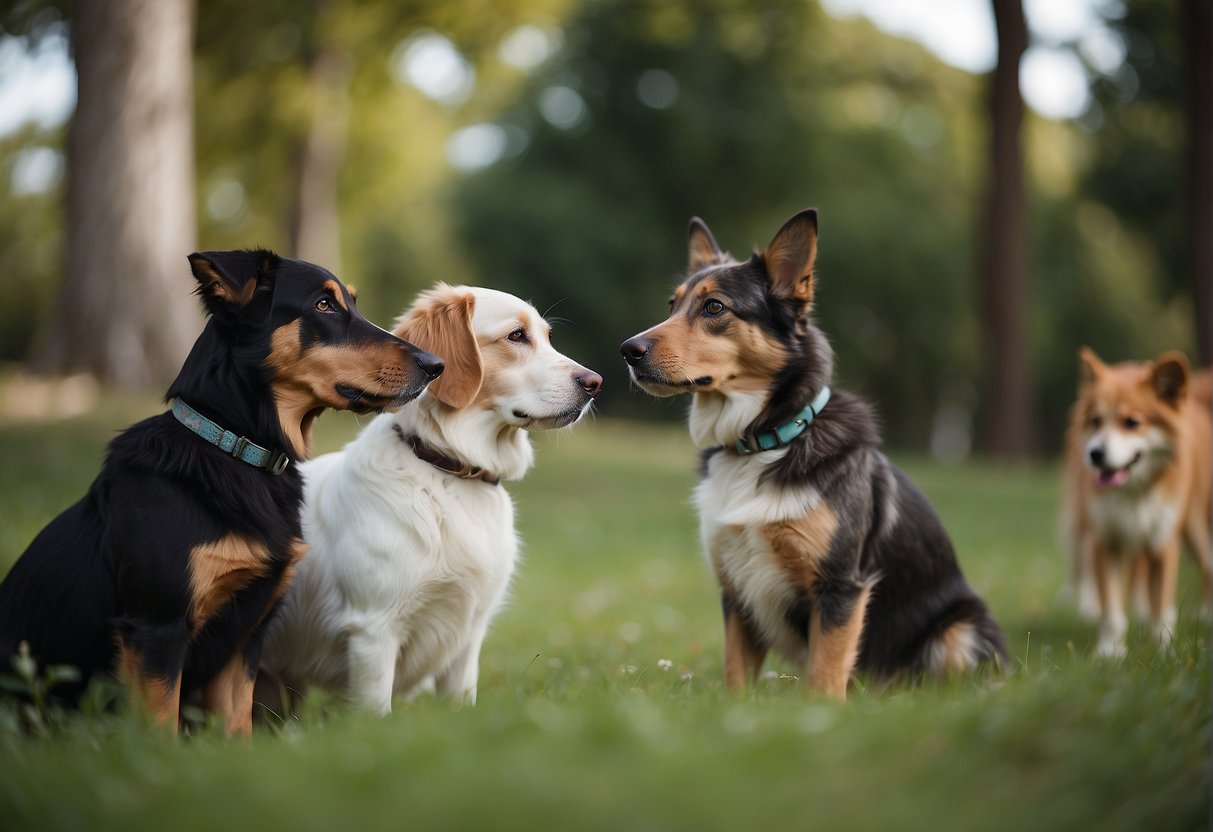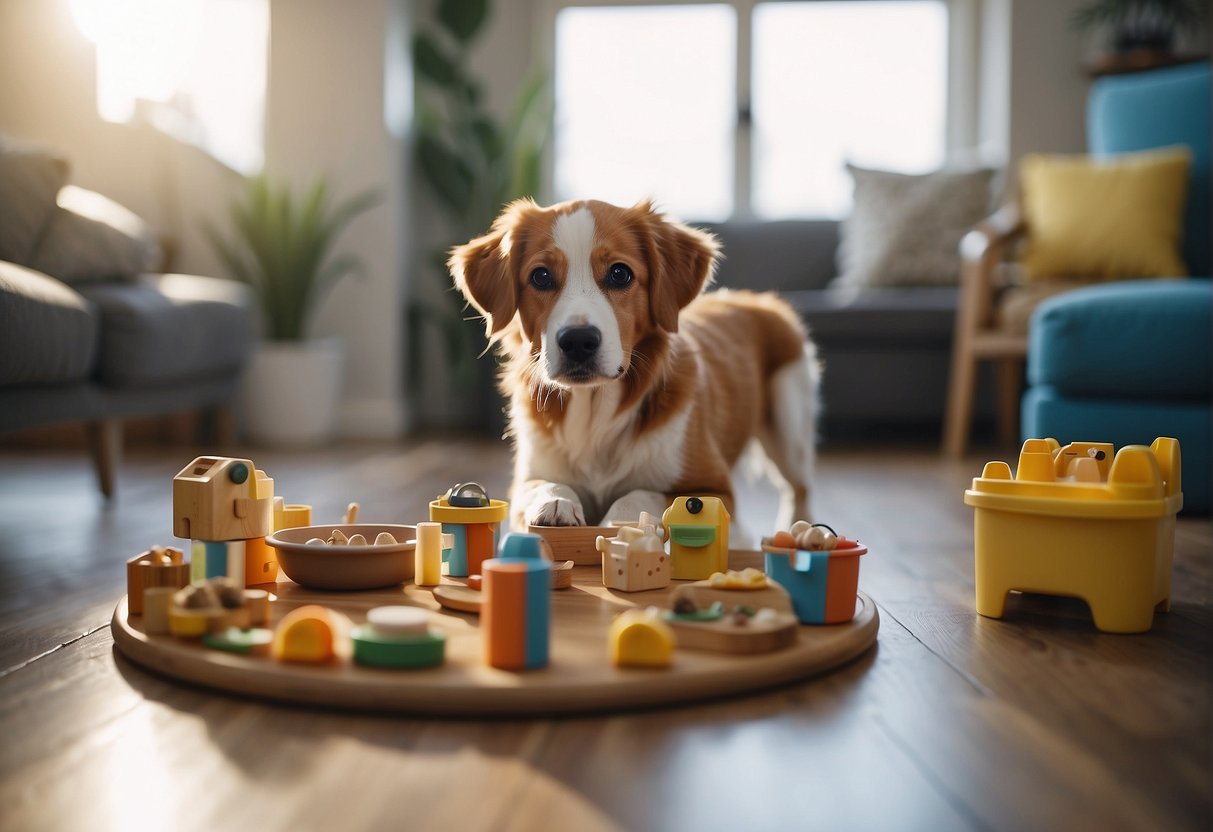When you decide to bring a new dog into a home already bustling with pets, it’s like adding a new member to the family. Just like people, your other pets need time to adjust. Preparation can go a long way in making sure both your new dog and your current pets feel comfortable with the change. It’s key to know that each pet is an individual. They have their own needs and personality. So, introductions should be done slowly and with careful observation.

Before your new dog arrives, create a safe space for them. This could be a room or a crate where they can retreat and relax without feeling threatened by other pets. Any first meetings should be controlled and done in a neutral space to prevent turf wars or territorial responses. Taking the time to train your existing pets beforehand can also help. Teach them basic commands. Ensure they behave well. This will make the integration smooth for all. Gradual introduction is key, with the aim of creating a positive association between the pets.
Key Takeaways
- A safe space for the new dog can aid in a stress-free introduction.
- Gradual, controlled introductions help establish positive relationships.
- Training existing pets can smooth the transition for the new dog and other pets.
Preparing for a New Dog: Basics of Multi-Pet Introduction

Bringing a new dog into your home is a big step, particularly when you have other pets. You’ll want to ensure a smooth transition to prevent stress and foster harmonious relationships from the start.
Know Your Current Pets’ Temperaments
Before the new dog arrives, think about the personalities of your pets at home. Are your cats the kings of their castle, or do your dogs like things just so? Understanding each pet’s temperament helps in creating a successful introduction. For example, an adult dog that’s calm and laid back may have no problem adjusting to a new pup, while a more anxious or territorial dog could require a more cautious approach. Jot down how your pets typically react to new situations to help tailor the integration process.
Understand the New Dog’s Background
Next up, get the scoop on the new dog. Was it living in a shelter, or is it an adopted adult dog with a history of its own? A shelter dog might be more stressed due to the recent changes it’s faced. If you’re adopting, the organization may have insights into how the dog behaves around cats or other animals. Armed with this knowledge, you can anticipate possible challenges and prep accordingly.
Prepare Yourself for the Integration Process
Lastly, it’s up to you to set the stage. Here’s how you can do that:
- Establish a Routine: Dogs thrive on routine. Start by setting up a schedule for feeding, walks, and playtime.
- Create a Safe Space: Whether it’s a crate or a separate room, ensure the new dog has a spot to relax and feel secure without feeling crowded by other pets.
- Lay Down the Ground Rules: Introduce the new dog to your house rules gradually but firmly. Training takes persistence and patience.
Keep in mind that all pets need time to adjust. Introduce them slowly, supervise their interactions and have lots of patience. It’s all about making the transition as stress-free as possible.
Setting the Physical Environment

When a new dog walks into your life and home, it’s super important to make sure your house is set up to keep all pets comfortable and stress-free. Here’s how you can get the space ready for a smooth introduction.
Create Separate Safe Spaces
You’ll want to have separate areas where each pet can relax without feeling threatened. This means setting up a safe spot for your new dog and making sure your current pets still have their own hangouts too. Think of it as giving everyone their own room. For your new dog, a crate is like a private den where they can chill out, while gates or even a different room can work for your other pets. Safety is key, so make sure these spaces are cozy and escape-proof.
Ensure Equal Access to Resources
Pets can get kind of jealous, so it’s important to play fair with the stuff they need. Make sure you have enough bowls for food and water, so everyone has their own—you don’t want any arguments during dinner time. Each pet should have their own toys too, so nobody feels left out. Here’s a quick checklist:
- Bowls: One set for each pet.
- Toys: Plenty to go around.
- Beds: A comfy place for each pet to sleep.
Remember, when you bring a new dog into a space where your pets have already set up house rules, it’s like introducing a new kid to the classroom. They’ll all need to learn to share the environment and get along, but having their own things makes it way easier.
Behavioral Adjustments Before the Introduction

Before bringing a new dog into your home, it’s essential to prepare your existing pets for the change. This preparation includes behavioral adjustments that will help maintain control and reduce stress for everyone involved.
Refresh Obedience Training
Obedience training is crucial for creating a sense of order and trust with your pets. Start with the basics:
- Sit: Have your pet sit before receiving treats or food. This reinforces patience and control.
- Stay: Practice the stay command to help with impulse control, especially important when the new dog arrives.
- Come: Ensuring your pet responds to the come command helps manage and prevent chaotic situations.
Remember to provide praise and treats as rewards for good behavior. This positive reinforcement strengthens the bond between you and your pet and increases their willingness to follow rules.
Implement Calming Techniques
Introducing a new dog can be stressful for your pets. To help them stay relaxed, try these calming techniques:
- Create a routine: Keep feeding times and walks consistent to give your pets a sense of security.
- Leash training: Maintain control during walks by keeping your pet close and attentive to your commands.
- Safe spaces: Provide a quiet area your pet can retreat to when they feel overwhelmed.
By using these training methods and techniques, your pets will be better adjusted to accept a new member into their space. It’s all about reinforcing trust and establishing control, so the transition is as smooth as possible for your entire household.
Introducing Your New Dog to Other Pets

When you’re ready to introduce your new dog to your other pets, it’s all about making sure everyone feels safe and comfortable. Let’s break down the steps into two important parts.
First Meeting: Controlled and Gradual
When you first introduce your new dog to your current pets, plan for a controlled and gradual meeting. It’s best not to rush things. Here’s how you can do it:
Neutral Territory: Start in a neutral location, like a park, where your current pets don’t feel like their territory is being invaded. This helps put everyone on a more even keel.
Leash and Space: Keep your new dog on a leash, but give them enough space to move freely. This helps manage the situation while allowing them to explore at a comfortable distance.
Step by Step: Introduce them slowly. Let them have a sniff and a look at each other, but don’t force them to be close. If you’re introducing them to another dog, consider having someone else there to help manage both leashes.
Remember, during this meeting, safety is your top priority. If you sense any tension, it’s okay to separate them and try again later.
Reading the Body Language of Each Animal
Understanding what the pets are telling you through their body language keeps stress levels down and helps build trust:
- Relaxed Posture: Look for a relaxed body and face. This means they’re likely feeling good about the situation.
- Growling or Hissing: These are warning signs. If you hear growling or hissing, it’s time to calmly separate the pets and give them more time to adjust to the idea of a new pal.
- Stress Signals: Watch for signs of stress, like pacing, panting, or hiding. If you see these, it’s a signal to slow down the introduction process.
Take these cues seriously and proceed with patience. Over time, they’ll start to understand that there’s no threat, building the foundation for a good relationship between your pets.
Health Considerations

Before introducing a new dog into your home, ensuring the health of all pets is crucial. It’s like making sure everyone is ready for a new roommate—no one should have a cold!
Health Check for All Pets
You’ll want to start with a clean bill of health for every pet in the house. Schedule a visit to the vet for a physical exam. This checkup is a safety step to rule out any hidden illnesses that could spread or cause stress among your pets.
- Current Pet Checkup: A trip to the veterinarian helps to catch any undiagnosed problems.
- New Dog Checkup: Don’t forget a vet visit for your incoming dog too!
Vaccinations and Parasite Control
Staying updated on vaccinations and parasite control is a big deal. It’s all about keeping everyone healthy and safe.
Vaccinations: Make sure all pets are up-to-date with vaccinations to prevent the spread of diseases.
- DHLPP for dogs – Protects against distemper, hepatitis, leptospirosis, parvovirus, and parainfluenza.
- Rabies: Both new and current pets should have this essential vaccine.
Flea and Tick Prevention: Apply proper treatments to protect your pets from these unwanted guests.
Remember, diets and daily routines will need to adapt to include your new dog, but getting the health stuff sorted out first makes everything smoother.
Post-Introduction Monitoring and Adjustment

After you’ve introduced a new dog to your other pets, the real work begins. It’s crucial to keep a close eye on their interactions and be ready to step in if necessary. Being patient and prepared can help ease the transition for your whole family.
Supervise Interactions
It’s all about safety when your new dog and family pets are getting to know each other. Keep their first few hangout sessions short and sweet. You have to be like a referee during these times, ready to blow the whistle if play turns into something less friendly. Look out for the telltale signs in their body language—like a stiff tail or flattened ears—and separate them if things get heated.
Adjust Based on Pets’ Reactions
Your pets will tell you a lot through their actions. If one of your pets is hiding or acting out, they’re probably stressed. That’s when you need to adjust your approach. You might need to give them more quiet time or introduce a comfort item like a favorite blanket to help them stay calm. Remember, every pet is different. Some might hit it off from the start, while others take time to warm up.
Schedule Joint Activities Gradually
Ease into a routine where your pets do things together. Start with activities that don’t require much interaction, like chilling in the same room with you. Then, you can graduate to more interactive stuff, like playtime with toys or going for a walk together. Your goal is to help them form a bond, but every step on the schedule should be taken at a pace that keeps everyone happy and comfortable.
Final Thoughts

When introducing a new dog into your home, remember that a smooth transition takes time. Patience is your best ally in this change. Your existing pets will need space and time to build trust with their new housemate.
Here’s what you should keep in mind:
Transition: Treat the introduction as a gradual process. This is not a race, and rushing can lead to setbacks. Ensure each pet feels safe and secure throughout the process.
Patience: Expect a period of adjustment. Just like people, animals need time to get used to new things. Some pets may adapt quickly, while others might take longer. Your calm energy is crucial.
Trust: Trust develops out of consistent and positive interactions. Supervise early meetings and look for signs of stress or discomfort. Adjust your approach based on your pets’ reactions.
Bond: Create opportunities for your pets to form positive associations with each other. Shared activities like walks or playtime can help strengthen their relationship.
Relaxed: Keep the atmosphere in your home calm. A relaxed environment makes for a smoother introduction. If you’re anxious, your pets might be too.
